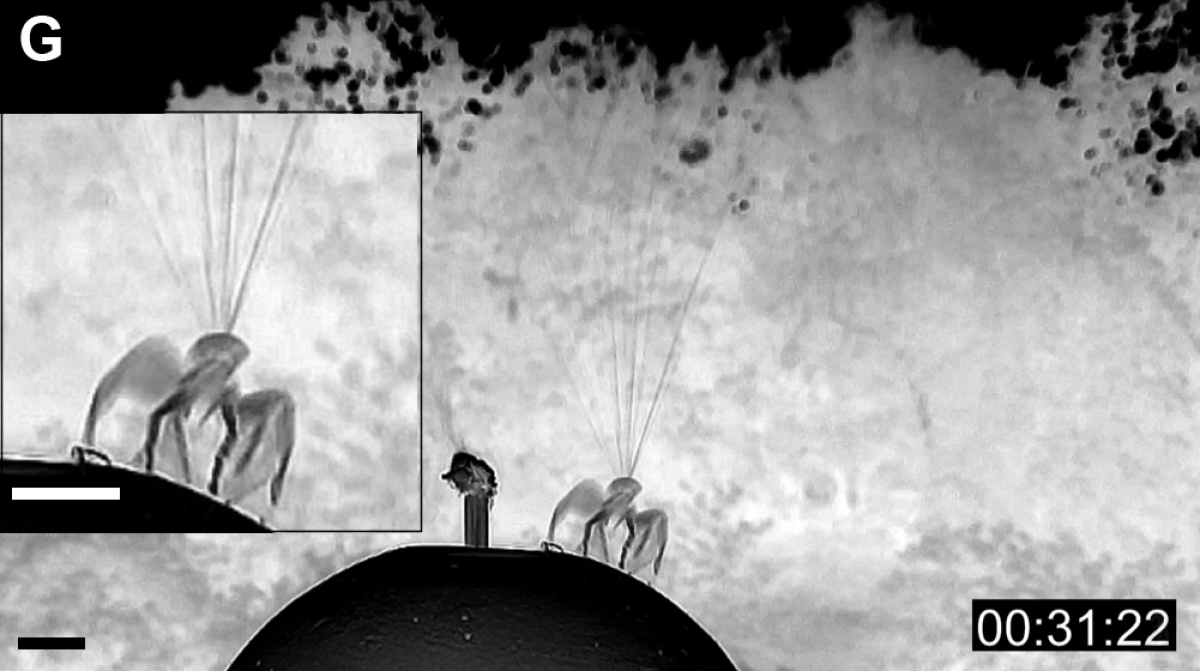Crab spiders spin dozens of fine silk fibers into parachutes that let them hitch a ride on even the lightest breeze, scientists have observed.
The eight-legged beasts, it turns out, are skilled aviators—testing out the wind with their front legs until they find the perfect breeze. Researchers explored their aeronautic prowess in a study published in the journal PLOS Biology.
Although scientists have studied spider flight before, this is the first time someone's taken a serious look at the mechanisms behind the phenomenon. The team identified the physical properties of the silk balloons—how many threads a spider pumps out and how long they are—as well as the tiny aviator's preferred weather conditions.

Researchers watched their crab spiders take flight in natural winds in a Berlin park and then in laboratory conditions to home in on their tiny threads. The spiders poked out their front legs again and again to sense wind conditions, before shimmying in the optimal direction.
"The pre-flight behaviors we observed suggest that crab spiders are evaluating meteorological conditions before their takeoff," study author Moonsung Cho from the Technical University of Berlin said in a statement. "Ballooning is likely not just a random launch into the wind, but one that occurs when conditions most favor a productive journey."
Read more: World's oldest spider dies aged 43 after wasp attack
When the perfect breeze comes along, the spiders spurt dozens of 10-foot-long silk threads to create a triangular sheet that acts as a parachute. These fibers are incredibly thin at about 200 nanometers across. That's about 500 times thinner than an average human hair. The clever critters then deploy a final silk anchoring line as they launch.

It's these incredibly thin fibers that help the spiders catch a ride on even the lightest breeze, Cho told Gizmodo. "Most winged insects flap their wings to build a vortex of air to lift their bodies and make them float," he said. But, the spiders' barely-there threads can harness the viscosity of the air. "From the viewpoint of spider silk," Cho said, "the air is like honey."
Watching this impressive behavior again and again, the researchers discovered the perfect conditions for a creepy crawly cruise; a gentle breeze of around seven miles per hour with a light updraft.
Read more: Scorpion-tailed spider chimera found in amber is missing link between ancient arachnids and modern spiders
"You need to see it to believe it," Cheryl Hayashi, a spider biologist with the American Museum of Natural History who was not involved in the study, told Gizmodo. "It gives you a deeper appreciation for how spiders have evolved to do this feat—they're literally sailing through the air."
Luckily for arachnophobes, it's mostly smaller spiders that balloon. The 5mm-long crab spiders in the study are pretty large for a spider that soars.
"Over millions of years, these spiders fine-tuned the use of these proteins for certain functions," including flying, Hayashi told Gizmodo. "I think we could certainly get some ideas from them about aerodynamics and moving things through the air."
Uncommon Knowledge
Newsweek is committed to challenging conventional wisdom and finding connections in the search for common ground.
Newsweek is committed to challenging conventional wisdom and finding connections in the search for common ground.
About the writer
Katherine Hignett is a reporter based in London. She currently covers current affairs, health and science. Prior to joining Newsweek ... Read more
To read how Newsweek uses AI as a newsroom tool, Click here.








